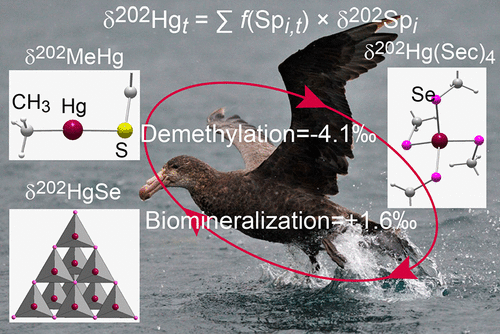当前位置:
X-MOL 学术
›
Environ. Sci. Technol.
›
论文详情
Our official English website, www.x-mol.net, welcomes your feedback! (Note: you will need to create a separate account there.)
Mercury Isotope Fractionation by Internal Demethylation and Biomineralization Reactions in Seabirds: Implications for Environmental Mercury Science
Environmental Science & Technology ( IF 11.4 ) Pub Date : 2021-10-01 , DOI: 10.1021/acs.est.1c04388 Alain Manceau 1 , Romain Brossier 1 , Sarah E Janssen 2 , Tylor J Rosera 2 , David P Krabbenhoft 2 , Yves Cherel 3 , Paco Bustamante 4 , Brett A Poulin 5
Environmental Science & Technology ( IF 11.4 ) Pub Date : 2021-10-01 , DOI: 10.1021/acs.est.1c04388 Alain Manceau 1 , Romain Brossier 1 , Sarah E Janssen 2 , Tylor J Rosera 2 , David P Krabbenhoft 2 , Yves Cherel 3 , Paco Bustamante 4 , Brett A Poulin 5
Affiliation

|
A prerequisite for environmental and toxicological applications of mercury (Hg) stable isotopes in wildlife and humans is quantifying the isotopic fractionation of biological reactions. Here, we measured stable Hg isotope values of relevant tissues of giant petrels (Macronectes spp.). Isotopic data were interpreted with published HR-XANES spectroscopic data that document a stepwise transformation of methylmercury (MeHg) to Hg-tetraselenolate (Hg(Sec)4) and mercury selenide (HgSe) (Sec = selenocysteine). By mathematical inversion of isotopic and spectroscopic data, identical δ202Hg values for MeHg (2.69 ± 0.04‰), Hg(Sec)4 (−1.37 ± 0.06‰), and HgSe (0.18 ± 0.02‰) were determined in 23 tissues of eight birds from the Kerguelen Islands and Adélie Land (Antarctica). Isotopic differences in δ202Hg between MeHg and Hg(Sec)4 (−4.1 ± 0.1‰) reflect mass-dependent fractionation from a kinetic isotope effect due to the MeHg → Hg(Sec)4 demethylation reaction. Surprisingly, Hg(Sec)4 and HgSe differed isotopically in δ202Hg (+1.6 ± 0.1‰) and mass-independent anomalies (i.e., changes in Δ199Hg of ≤0.3‰), consistent with equilibrium isotope effects of mass-dependent and nuclear volume fractionation from Hg(Sec)4 → HgSe biomineralization. The invariance of species-specific δ202Hg values across tissues and individual birds reflects the kinetic lability of Hg-ligand bonds and tissue-specific redistribution of MeHg and inorganic Hg, likely as Hg(Sec)4. These observations provide fundamental information necessary to improve the interpretation of stable Hg isotope data and provoke a revisitation of processes governing isotopic fractionation in biota and toxicological risk assessment in wildlife.
中文翻译:

海鸟内部去甲基化和生物矿化反应的汞同位素分馏:对环境汞科学的影响
汞 (Hg) 稳定同位素在野生动物和人类中的环境和毒理学应用的先决条件是量化生物反应的同位素分馏。在这里,我们测量了巨型海燕( Macronectes spp.)相关组织的稳定 Hg 同位素值。同位素数据用已发表的 HR-XANES 光谱数据解释,该数据记录了甲基汞 (MeHg) 逐步转变为四硒化汞 (Hg(Sec) 4 ) 和硒化汞 (HgSe) (Sec = 硒代半胱氨酸)。通过同位素和光谱数据的数学反演, MeHg (2.69 ± 0.04‰)、Hg(Sec) 4的 δ 202 Hg 值相同(-1.37 ± 0.06‰) 和 HgSe (0.18 ± 0.02‰) 在来自 Kerguelen 群岛和阿德利地 (南极洲) 的 8 只鸟类的 23 个组织中测定。MeHg 和 Hg(Sec) 4之间 δ 202 Hg的同位素差异(-4.1 ± 0.1‰) 反映了由于 MeHg → Hg(Sec) 4去甲基化反应导致的动力学同位素效应的质量依赖性分馏。令人惊讶的是,Hg(Sec) 4和 HgSe 在 δ 202 Hg (+1.6 ± 0.1‰) 和与质量无关的异常(即 Δ 199 Hg 的变化≤0.3‰)中存在同位素差异,这与质量相关的平衡同位素效应一致Hg(Sec) 4 → HgSe 生物矿化的核体积分馏。物种特异性 δ 202的不变性跨组织和个体禽类的 Hg 值反映了 Hg-配体键的动力学不稳定性以及 MeHg 和无机 Hg 的组织特异性再分布,可能是 Hg(Sec) 4。这些观察结果为改进稳定汞同位素数据的解释提供了必要的基本信息,并引发了对生物群同位素分馏和野生动物毒理学风险评估过程的重新审视。
更新日期:2021-10-19
中文翻译:

海鸟内部去甲基化和生物矿化反应的汞同位素分馏:对环境汞科学的影响
汞 (Hg) 稳定同位素在野生动物和人类中的环境和毒理学应用的先决条件是量化生物反应的同位素分馏。在这里,我们测量了巨型海燕( Macronectes spp.)相关组织的稳定 Hg 同位素值。同位素数据用已发表的 HR-XANES 光谱数据解释,该数据记录了甲基汞 (MeHg) 逐步转变为四硒化汞 (Hg(Sec) 4 ) 和硒化汞 (HgSe) (Sec = 硒代半胱氨酸)。通过同位素和光谱数据的数学反演, MeHg (2.69 ± 0.04‰)、Hg(Sec) 4的 δ 202 Hg 值相同(-1.37 ± 0.06‰) 和 HgSe (0.18 ± 0.02‰) 在来自 Kerguelen 群岛和阿德利地 (南极洲) 的 8 只鸟类的 23 个组织中测定。MeHg 和 Hg(Sec) 4之间 δ 202 Hg的同位素差异(-4.1 ± 0.1‰) 反映了由于 MeHg → Hg(Sec) 4去甲基化反应导致的动力学同位素效应的质量依赖性分馏。令人惊讶的是,Hg(Sec) 4和 HgSe 在 δ 202 Hg (+1.6 ± 0.1‰) 和与质量无关的异常(即 Δ 199 Hg 的变化≤0.3‰)中存在同位素差异,这与质量相关的平衡同位素效应一致Hg(Sec) 4 → HgSe 生物矿化的核体积分馏。物种特异性 δ 202的不变性跨组织和个体禽类的 Hg 值反映了 Hg-配体键的动力学不稳定性以及 MeHg 和无机 Hg 的组织特异性再分布,可能是 Hg(Sec) 4。这些观察结果为改进稳定汞同位素数据的解释提供了必要的基本信息,并引发了对生物群同位素分馏和野生动物毒理学风险评估过程的重新审视。


























 京公网安备 11010802027423号
京公网安备 11010802027423号